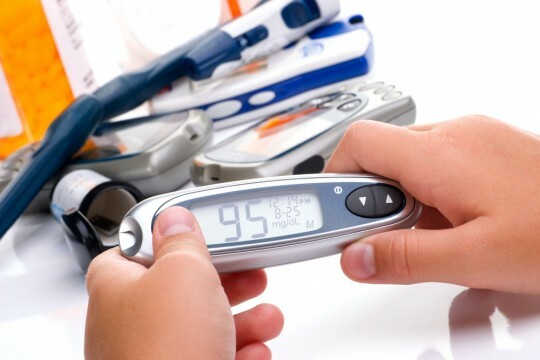With the increase in the well-being of the population, the number of people diagnosed with diabetes mellitus is simultaneously increasing. Along with cardiological and oncological problems, he is among the first diseases that provoke disability or premature departure from life. Deeply studying the causes of diabetes, its signs, forms of treatment, the norm of sugar in the blood, you protect yourself from serious trouble.
Types of the disease and its types

Women are most often affected by the disorder, this is due to the peculiarities of the hormonal background and its frequent restructuring. Diabetes distinguish between sugar and non-sugar. In turn, each species has different prerequisites for occurrence and is divided into 2 types.
Diabetes mellitus
There are two reasons why the blood sugar level in women exceeds the norm. Diabetes of an insulin-dependent type occurs as a result of a failure of the endocrine system, when the pancreas does not fully provide the woman's body with insulin, necessary for the breakdown of sugar in the blood.
Most recently, the main age category of type 1 diabetes was people under 30 years old .Recent studies have revealed a tendency to raise the age threshold to 40 years.The risk of detecting an autoimmune disease is increased as a result of:
- The transferred diseases associated with viral infection.
- Consequences of problems of oncological nature.
- Stress state over a long period.
- Failure of the immune system, in which the produced antibodies destructively affect the cellular structure of the pancreas.
Type 2 diabetes is characterized as non-insulin-dependent. Its essence lies in the insensitivity of the cells of the body to the insulin produced. One of the leading culprits of a serious diagnosis is overweight and lack of motor activity of a woman. Typical problems often develop after 30 years.
An hereditary factor plays an important role in type 2 diabetes mellitus. In some cases, diabetes is transmitted from a pregnant woman to a newborn. Insulin-dependent diabetes, belonging to type 1, is inherited in the ratio 1:10.The treatment is more complex, so timely diagnosis is extremely important.
Diabetes insipidus

It is extremely rare diabetes insipidus. Distinctive feature of the disease are functional disorders of the brain. Deviations provoke urinary excretion in an amount significantly higher than the norm, as well as excessive thirst.
The following cerebral lesions can lead to central diabetes insipidus:
- or tumor, or metastases on the pituitary or hypothalamus;
- encephalitis;
- syphilis;
- brain injury or complications after operations on it;
- congenital anomaly.
In addition to abnormalities in the functioning of the brain, diabetes insipidus is formed as a result of a malfunction of normal kidney function.
How the
disease manifests After examining the signs of diabetes in women, you will be able to pay attention in time to the changes that have occurred in the body and begin to act in the early stages, not allowing serious complications.
Changes in the body with increased sugar
To begin with, it should be determined what is considered the norm for women, and what information about blood sugar refers to deviations.
| Gastric status | Indices, mmol / g | Value |
| Fasting morning | 3.8-6.0 | norm |
| 6.1-6.9 | limit | |
| more than 7.0 | probability of diabetes | |
| less than 3,9 | initialstage of hypoglycemia | |
| 2,8-3,9 | hypoglycemia | |
| 2,8 | insulin shock | |
| After 2 hours after ingestion | 6.7-7.8 | norm |
| 7.9 and above | probability of diabetes | |
| Regardless of food intake, constantly | more than 11.0 | probability of diabetes |

People who regularly take a blood test for sahp with a preventive purpose, are extremely rare. You will get a chance to stop the disease in the early stages as a result of qualified treatment of , promptly paying attention to the main symptoms of diabetes in women:
- a sharp change in body weight towards increase or decrease;
- a sense of thirst on an ongoing basis;
- condition of hair and nail plates is unsatisfactory;
- skin of face and hands changes pigmentation;
- increased weakness, often accompanied by dizziness, chronic fatigue;
- weakened immunity, accompanied by frequent viral infections;
- skin itching due to its dryness;
- delayed wound healing process.
After 50 years, there is a chance of loss of vision, there is blurred vision. It is not necessary to panic, having found out in itself one or several displays of illness. A timely visit to a medical facility will help dispel any doubts that arise. If the blood sugar level is higher than normal, then the appropriate course of treatment should be started. In addition to the main changes, there are signs of diabetes mellitus in women, manifested in the gynecological area:
- menstrual cycle disorder;
- presence of microcracks on the mucosa, the appearance of dry skin;
- through microcracks possible penetration of viral infections, fungi and the development of inflammatory processes;
- in the vagina changes the acid-base balance.
Often, women after 50 years of age write off the emerging problems for menopause. However, care should not be taken, this applies not only to women of age, but also to pregnant women. The main purpose of establishing the correct diagnosis and type of diabetes is the need to provide appropriate treatment. The most accessible method of research is the analysis that reveals the level of sugar in the blood. Another argument that speaks of the invaluable benefit of a blood test is diabetes in a latent form. Untimely treatment in such situations leads to the development of complications.
Manifestation of diabetes insipidus

Regardless of the reasons that led to the formation of diabetes insipidus, the disease has almost identical symptoms in all its variants. However, the degree of expression depends on two factors:
- how much the receptors of nephron tubular receptors are resistant to vasopressin;
- at what level is the lack of antidiuretic hormone, or its complete absence.
Women and men are subject to the problem after 20 years, the risk limit ends after 40 years. The first symptoms of diabetes insipid type in women are the following:
- Clearly different dehydration: dry mouth and the entire skin, weight loss.
- The consumption of liquid in large quantities leads to stretching of the stomach and its descent.
- Insufficient water in the body leads to disturbances in the digestive enzymes. Decreased appetite is accompanied by the development of colitis or gastritis, the appearance of constipation.
- The bladder is stretched.
- Insufficient sweating.
- Against the background of low blood pressure, the heart rate increases.
- Occasionally, for no apparent reason, nausea, leading to vomiting, is disturbing.
- Increased fatigue, muscle pain.
- Body temperature is above normal.
- Occasionally, bedwetting occurs at night.
- Disorder of the menstrual cycle.
On the background of physical suffering in a patient with diabetes insipidus, emotional disorders develop:
- irritability, unstable mood, growing into psychosis;
- insomnia, and as a result, headaches;
- decreased mental activity.
It is impossible to ignore such violations. Timely advice from specialists helps to reduce the period of treatment.
Features of abnormalities in pregnant women
Diabetes in pregnant women develops infrequently. The probability of detecting a failure in pregnant women does not exceed 6% of the threshold. In most cases, after birth, in parallel with the restoration of the hormonal background, gestational diabetes mellitus disappears without additional treatment. Much less often, diabetes mellitus, formed in pregnant women, degenerates into a normal type.
The most dangerous period occurs in girls from 4 to 8 months of pregnancy, this is due to oppression of insulin with hormones released by the placenta. The formation of the disease in pregnant women is not accompanied by the manifestation of symptoms, the diagnosis is established in the course of a planned examination, so it is classified as a hidden type of diabetes.
Do not neglect prophylactic examinations after 30 years, if a woman is overweight, the pregnant woman had diabetes, the fetus weighed more than 4.5 kg, or there were pathologies.
Regular monitoring of blood sugar, especially in women over 30 years of age and pregnant women, can prevent complications from developing a serious disease and facilitate the treatment process. Observance of moderation in eating, active lifestyles and lack of constant stress pose a significant barrier to the formation of a serious illness.



